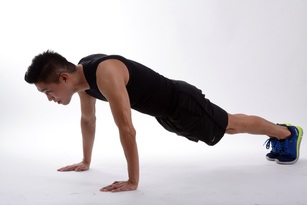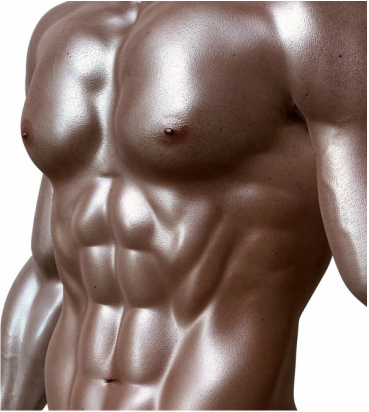
Many of my patients have worked with trainers or used workouts found on the internet to help them strengthen their core muscles prior to seeing me for back pain. Sit-ups on the slant board, crunches, and Roman Chair back extensions are popular core exercises. Certain yoga poses seem to engage the core to a degree and can offer a kind of introduction to core strengthening as well. But perhaps the most commonly promoted exercise for strengthening the core is the plank. Planks are performed by getting into a push-up position (putting your weight either on your hands or elbows) and then holding the legs and torso in a straight line above the floor for a protracted period of time.
The core can be thought of as having four separate quadrants: front (rectus abdominus), back (lower back and buttock muscles), and left and right sides (obliques and transversus abdominus). Unlike sit-ups, crunches, and back extensions which each work only one of the four quadrants of the core, planks, when done correctly, engage three of the four quadrants (front and sides). In this way, planks are a more comprehensive core exercise than sit-ups, crunches, or back extensions. But there is a bit more to the story and before we rate planks as a core exercise we need to discuss the differences between exercises that involve motion and those that do not.
Exercises that cause muscles to shorten as they contract are referred to as concentric exercises, while exercises that cause muscles to lengthen as they contract are referred to as eccentric exercises. When you do a push up, the part where you move upward from the ground is powered by concentric contraction of chest (pectoral) and triceps muscles which become progressively shorter the higher up you go. If you then lower yourself quite slowly to touch your chest back down to the floor, those same muscles progressively lengthen while contracting, resulting in eccentric work. Planks do not involve movement, so there is neither shortening nor lengthening of muscle fibers. Exercises that involve muscle contraction without motion (shortening or lengthening of muscle fibers) are referred to isometric exercises.
Of the three forms of exercise (concentric, eccentric, and isometric), isometric conditioning is the least effective for building muscle strength. Isometric exercises such as planks are often used in clinical practice as the first phase of rehabilitation because they are a gentler form of exercise and carry less risk of injury when patients are de-conditioned and particularly vulnerable. Following surgeries or prolonged immobilization, planks, yoga poses, and other forms of isometric exercise can be very useful for establishing base stability safely. But base stability is insufficient for back health and will not provide a sculpted, chiseled mid-section.
Kore Power Trainer offers three levels of workouts: Core Stabilization, Basic Workout, and Advanced Workout. The Core Stabilization routine engages each of the four quadrants of the core in isometric exercise for one minute. This makes it more effective than planks which do not engage the back quadrant. Once Core Stabilization becomes easy to do, we recommend that you move to the Basic Workout which involves both concentric and eccentric work. Four minutes of the Basic Workout, 3-5 times per week, can build sufficient core strength to reduce, eliminate, and prevent many forms of chronic back pain as well as help give a chiseled appearance to the mid-section.
Though popular in the fitness world (for now), planks actually rank quite low as a core strengthening exercise. For a truly powerful core and a sculpted mid-section, you must do concentric and eccentric work. We invite you to try 4 minutes on a Kore Power Trainer.
The core can be thought of as having four separate quadrants: front (rectus abdominus), back (lower back and buttock muscles), and left and right sides (obliques and transversus abdominus). Unlike sit-ups, crunches, and back extensions which each work only one of the four quadrants of the core, planks, when done correctly, engage three of the four quadrants (front and sides). In this way, planks are a more comprehensive core exercise than sit-ups, crunches, or back extensions. But there is a bit more to the story and before we rate planks as a core exercise we need to discuss the differences between exercises that involve motion and those that do not.
Exercises that cause muscles to shorten as they contract are referred to as concentric exercises, while exercises that cause muscles to lengthen as they contract are referred to as eccentric exercises. When you do a push up, the part where you move upward from the ground is powered by concentric contraction of chest (pectoral) and triceps muscles which become progressively shorter the higher up you go. If you then lower yourself quite slowly to touch your chest back down to the floor, those same muscles progressively lengthen while contracting, resulting in eccentric work. Planks do not involve movement, so there is neither shortening nor lengthening of muscle fibers. Exercises that involve muscle contraction without motion (shortening or lengthening of muscle fibers) are referred to isometric exercises.
Of the three forms of exercise (concentric, eccentric, and isometric), isometric conditioning is the least effective for building muscle strength. Isometric exercises such as planks are often used in clinical practice as the first phase of rehabilitation because they are a gentler form of exercise and carry less risk of injury when patients are de-conditioned and particularly vulnerable. Following surgeries or prolonged immobilization, planks, yoga poses, and other forms of isometric exercise can be very useful for establishing base stability safely. But base stability is insufficient for back health and will not provide a sculpted, chiseled mid-section.
Kore Power Trainer offers three levels of workouts: Core Stabilization, Basic Workout, and Advanced Workout. The Core Stabilization routine engages each of the four quadrants of the core in isometric exercise for one minute. This makes it more effective than planks which do not engage the back quadrant. Once Core Stabilization becomes easy to do, we recommend that you move to the Basic Workout which involves both concentric and eccentric work. Four minutes of the Basic Workout, 3-5 times per week, can build sufficient core strength to reduce, eliminate, and prevent many forms of chronic back pain as well as help give a chiseled appearance to the mid-section.
Though popular in the fitness world (for now), planks actually rank quite low as a core strengthening exercise. For a truly powerful core and a sculpted mid-section, you must do concentric and eccentric work. We invite you to try 4 minutes on a Kore Power Trainer.

 RSS Feed
RSS Feed